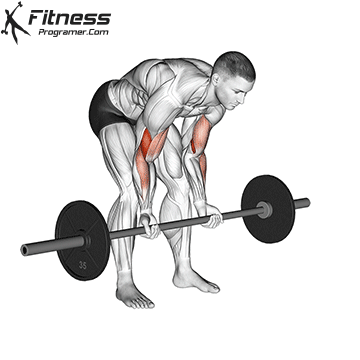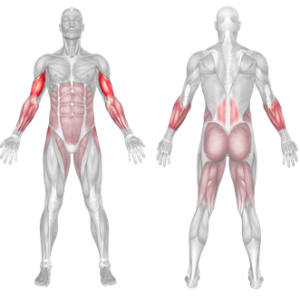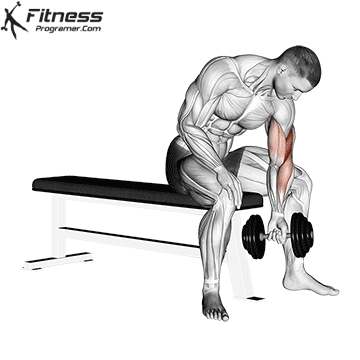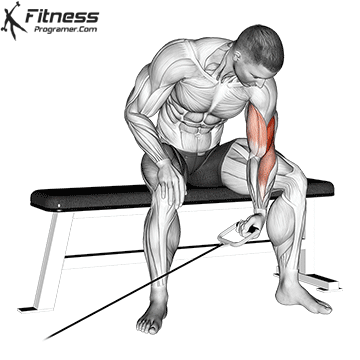Overview
The Standing Barbell Concentration Curl is a strength training exercise that primarily targets the brachialis and biceps brachii muscles of the arms. This is a challenging variation of the concentration curl, but instead of using dumbbells, barbells are used.
Despite the engagement of the lower back and core, the primary focus remains on isolating and targeting the arm muscles. This can be an effective way to add variety to your arm training routine and potentially stimulate muscle growth.
How to Perform:

- Begin by standing with your feet shoulder-width apart.
- Hold a barbell with both hands using a supinated (palms facing forward) grip, with your hands slightly wider than shoulder-width apart.
- Lean your upper body forward at the hips until it is nearly parallel to the floor. This forward lean helps isolate the biceps and engage the stabilizer muscles.
- Place your elbows on your thighs or knees for support, allowing your arms to hang straight down, fully extended.
- With your upper arms stationary, curl the barbell upwards towards your chest by flexing your elbows.
- Squeeze your biceps at the top of the movement.
- Slowly lower the barbell back down to the starting position, fully extending your arms.
Tips for Proper Form
Eliminate body sway by keeping your torso fixed throughout the lift.
Use a moderate weight to maintain strict form and avoid recruiting other muscles.
Keep the wrist neutral—avoid bending it backward or forward.
Breathe out as you curl the bar and inhale as you lower.
Focus on muscle squeeze rather than just moving the weight.
Common Mistakes
Using momentum: Swinging the bar reduces bicep isolation.
Flaring the elbow: Keep the elbow tucked to the side to maintain alignment.
Overextending at the bottom: Avoid locking out completely to keep tension on the muscle.
Going too heavy: Excessive weight compromises control and form.
Benefits of the Standing Barbell Concentration Curl
- Brachialis Emphasis: The brachialis, a muscle located beneath the biceps, is a significant target of this exercise. Developing the brachialis not only contributes to the size of your arms but also enhances overall arm strength. This can be especially beneficial for activities that involve pulling or lifting.
- Biceps Growth: While the brachialis is a primary focus, the biceps brachii also get actively engaged during the exercise. This dual muscle activation ensures balanced arm development, helping you achieve well-rounded biceps.
- Forearm Strengthening: Your forearm muscles play a crucial role in controlling the barbell during the curling motion. As a result, this exercise can help strengthen your forearm muscles, which is valuable for grip strength and various everyday tasks.
- Core Engagement: Maintaining proper form during the Standing Barbell Concentration Curl requires core engagement. Your core muscles work to stabilize your spine and maintain proper posture, preventing excessive arching or rounding of the lower back. This engagement helps protect the lower back and supports overall stability during the exercise.
- Hip Hinge Practice: The exercise involves a hip hinge movement pattern, similar to other compound exercises like deadlifts and bent-over rows. Practicing this movement pattern can improve your hip hinge technique, which is valuable for overall strength training.
Adding variety to your arm training routine can help prevent boredom and plateaus in progress. The Standing Barbell Concentration Curl offers a different stimulus compared to other bicep exercises, helping you challenge your muscles in new ways.
How to Incorporate Into Your Routine
For Beginners: Start with 2–3 sets of 8–10 reps using light weight to master form.
For Hypertrophy: Perform 3–4 sets of 10–12 reps with slow tempo and peak squeeze.
For Strength: Use heavier weights for 4–5 sets of 6–8 reps while maintaining strict control.
As a Finisher: Add 1–2 sets of high-rep (15–20) curls at the end of your arm workout for maximum pump.
Muscles Worked

Standing Barbell Concentration Curl: Variations
Frequently Asked Questions
Can I use an EZ curl bar for this exercise?
Yes. An EZ curl bar can reduce wrist strain while still providing strong bicep activation.
Should I work both arms together or one at a time?
One arm at a time is best for maximum concentration and eliminating momentum.
How heavy should I go?
Choose a weight that allows you to maintain strict form for all reps without swinging.
Is standing better than seated?
Standing requires more core engagement, while seated offers slightly more stability—both are effective.
How often should I train this exercise?
1–2 times per week as part of an arm or pull workout is sufficient for most lifters.




